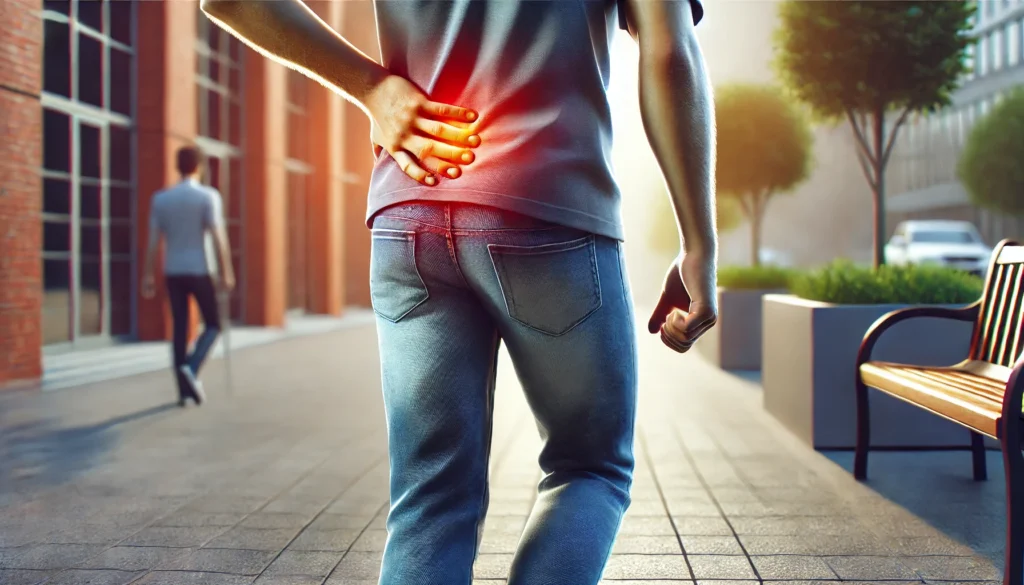Lower back pain is one of the most common health issues that people face. It’s something that can affect anyone, regardless of age or lifestyle. One of the most frustrating and limiting experiences is when lower back pain occurs while walking. If you’ve ever found yourself struggling with pain as you take a stroll, hike, or even go for a short walk, you’re not alone. In this article, we’ll explore the causes of lower back pain while walking, along with the best treatment options and prevention tips to help you stay pain-free and active.
What Causes Lower Back Pain When Walking?
Understanding the root cause of your pain is the first step toward effective treatment. There are several possible reasons why lower back pain may flare up when you walk:
Read Also: Vertebrogenic Low Back Pain: Causes, Symptoms, Treatment – Spinal-Related Low Back Pain!
1. Muscle Strain
One of the most common causes of lower back pain during walking is muscle strain. Overuse of the muscles in the lower back, especially after sudden activity or poor posture, can lead to tightness and pain. This type of strain can occur from carrying heavy loads, poor walking posture, or engaging in physical activities that stress your back muscles.
2. Degenerative Disc Disease
As we age, the discs in our spine can start to wear down. This can cause the vertebrae to rub against each other, leading to discomfort and pain while walking. Degenerative disc disease can result in stiffness, pain, and difficulty walking without discomfort.
3. Sciatica
Sciatica is a condition caused by irritation or compression of the sciatic nerve. This nerve runs from your lower back down to your legs. When it becomes inflamed, you may feel sharp pain radiating down your leg, especially when walking, sitting, or standing for long periods.
4. Spinal Stenosis
This condition often causes pain, numbness, or weakness in the lower back, which may worsen when walking, especially on inclined surfaces.
5. Scoliosis or Abnormal Spine Curvatures
Spinal deformities such as scoliosis (an abnormal curve of the spine) or kyphosis (excessive forward rounding of the upper back) can contribute to lower back pain. When walking, these abnormal postures can put additional strain on your lower back muscles, resulting in discomfort.
6. Poor Posture
Walking with poor posture, such as slumping or leaning forward, can strain the muscles in your lower back. It’s essential to maintain proper alignment while walking to avoid unnecessary tension and discomfort.
Symptoms of Lower Back Pain When Walking

When lower back pain occurs during walking, you may experience the following symptoms:
- Sharp or dull pain in the lower back area
- Stiffness or tightness in the lower back
- Radiating pain down the legs (especially with sciatica or spinal stenosis)
- Numbness or tingling sensations in the back or legs
- Difficulty walking or maintaining a normal gait
- Pain worsening after prolonged walking or standing
If these symptoms persist or worsen, it’s important to consult a healthcare provider for a proper diagnosis and treatment plan.
How to Treat Lower Back Pain When Walking
There are several ways to address and treat lower back pain, depending on the cause. Here are some common treatment options:
Rest and Recovery
For mild muscle strains or injuries, rest can help your muscles recover. Avoid strenuous activity, but try to remain mobile by walking slowly for short periods to prevent stiffness.
Physiotherapy Treatment
A physical therapist can guide you through exercises that strengthen the muscles of your lower back and core, improve posture, and increase flexibility. Regular physical therapy can help you manage and even prevent future pain while walking.
Pain Relief Treatments
Over-the-counter pain relievers like ibuprofen or acetaminophen can help reduce inflammation and ease pain. For more severe cases, your doctor may prescribe stronger medications or muscle relaxants
Hot/Cold Therapy
Applying heat or cold to your lower back can reduce pain and inflammation. Cold packs are effective for acute injuries, while heat therapy (like heating pads or warm baths) can help relax tight muscles and ease chronic pain.
Corticosteroid Injections
For severe conditions such as spinal stenosis or sciatica, corticosteroid injections can help reduce inflammation and relieve pain. These injections may provide temporary relief, but they can be part of an overall treatment plan.
surgical intervention
In rare cases, surgery may be necessary to correct structural issues, such as a herniated disc or spinal stenosis. Surgery is typically considered when conservative treatments don’t provide relief.
Prevention Tips for Lower Back Pain When Walking
While it’s impossible to completely eliminate the risk of lower back pain, there are steps you can take to prevent it from occurring or worsening:
Maintain Good Posture
Proper posture is crucial when walking. Keep your head up, shoulders back, and avoid slouching. Engage your core muscles to support your spine.
Strengthen Your Core
A strong core provides better support for your spine. Incorporate core-strengthening exercises, such as planks, pelvic tilts, and abdominal crunches, into your fitness routine.
Wear Proper Footwear
Choose shoes that offer good arch support and cushioning. Avoid high heels or shoes with inadequate support, as they can put added strain on your lower back.
Warm-Up Before Walking
Before heading out for a walk, warm up your muscles with gentle stretches or a slow-paced walk. Warming up helps increase blood flow to the muscles, preventing strain.
Engage in Regular Exercise
Regular exercise, including strength training and flexibility exercises, can keep your muscles strong and prevent stiffness. Activities like swimming, walking, and yoga are especially beneficial for back health.
Maintain a Healthy Weight
Excess weight puts additional pressure on your spine, which can contribute to back pain. Maintaining a healthy weight can alleviate stress on your lower back and reduce pain while walking.
When to See a Doctor
While most cases of lower back pain can be managed with self-care, it’s essential to consult a healthcare provider if:
- Your pain persists for more than a few days or worsens over time
- You experience numbness, tingling, or weakness in your legs
- Your pain is accompanied by unexplained weight loss, fever, or bowel/bladder issues
- You had a recent injury or fall
A doctor can provide a thorough evaluation, order imaging tests if needed, and recommend a personalized treatment plan.
FAQs:
1 What causes lower back pain when walking?
Lower back pain when walking can be caused by muscle strain, spinal issues like degenerative disc disease, sciatica, or poor posture.
2 How can I relieve lower back pain during walking?
Rest, physical therapy, medication, and hot/cold therapy can help relieve lower back pain while walking.
3 Can physical therapy help with lower back pain?
Yes, physical therapy helps strengthen muscles, improve posture, and increase flexibility, all of which can reduce pain while walking.
4 What is the best way to prevent lower back pain when walking?
Maintaining good posture, wearing supportive shoes, strengthening your core, and engaging in regular exercise can help prevent lower back pain.
5 When should I see a doctor for lower back pain?
You should see a doctor if the pain persists for several days, worsens, or is accompanied by other symptoms like numbness or weakness in the legs.
Conclusion:
Lower back pain when walking is a frustrating and often debilitating condition that can affect your quality of life. Understanding the underlying causes, such as muscle strain, degenerative conditions, or poor posture, is the first step toward effective management. With the right treatment, prevention strategies, and lifestyle adjustments, you can reduce the likelihood of experiencing pain while walking and enjoy a more active, pain-free life.











